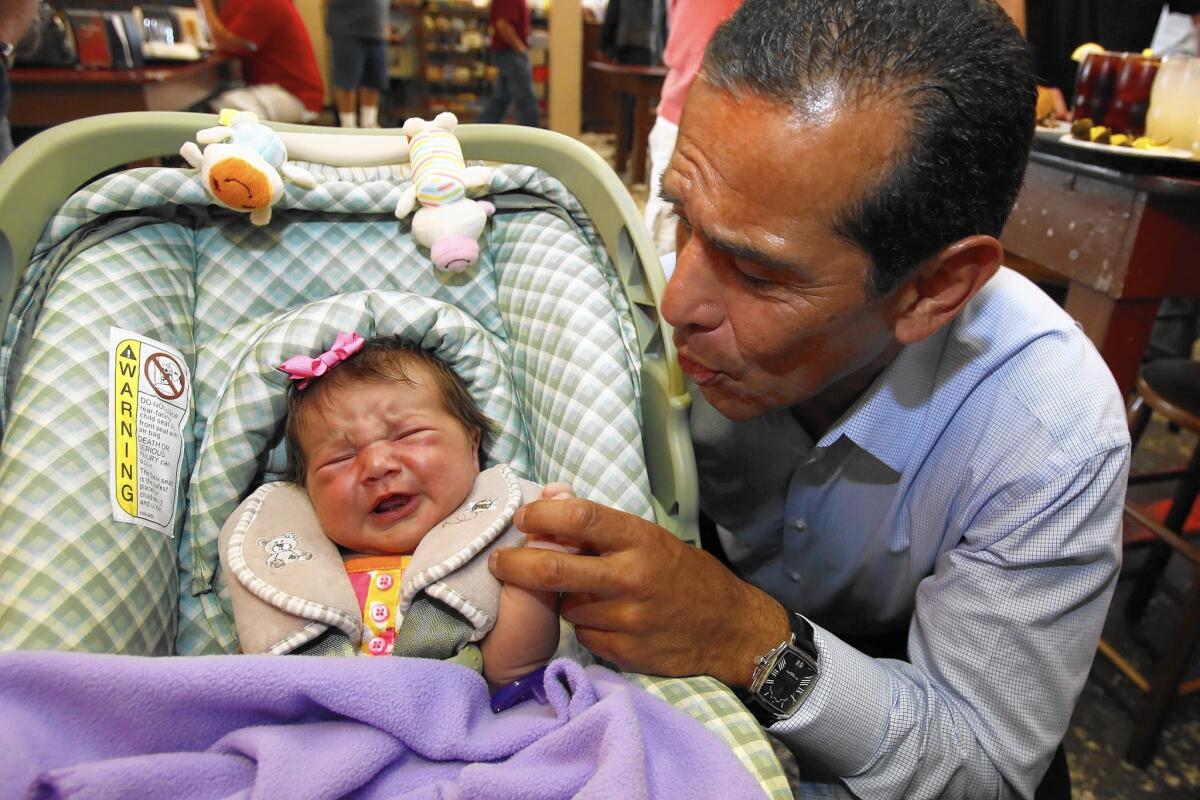Math is a factor in Villaraigosa’s decision whether to run for Senate

- Share via
Maybe Antonio Villaraigosa, the former Los Angeles mayor, has edged toward a run for the newly open U.S. Senate seat in 2016 for all the reasons he offered last weekend: that Californians are struggling to make ends meet and that the “needs of the people” are urgent.
Or maybe he’s just good at math.
The electoral arithmetic that governs California is central to decisions by a candidate like Villaraigosa. And it can be bleak: As a Latino candidate from Southern California, he faces long odds against winning a slot in a statewide general election. His chances are better if, as with the Senate contest, the race coincides with the heat of a presidential contest. But even then it could be tough.
That flies in the face of logic: Latino voters are ascendant, and Los Angeles is the population center of the state, so it seems a local candidate should have a leg up in any statewide contest. But this is the confounding reality: Horrible voter turnout in Southern California — and particularly in Los Angeles — puts locals at a distinct disadvantage compared with Democrats from Northern California. (Republicans do worse, of course, but their chances of statewide success are dismissed by most everyone.)
“The worst thing you can be is a male Latino Democrat from L.A.,” said Republican strategist Mike Madrid, setting aside his own party’s candidates. “There is no vote base.”
The best odds, added Madrid, who has studied turnout for years, go to a woman candidate from Northern California. A candidate with the profile of Sens. Dianne Feinstein or Barbara Boxer, who will be giving up, after 24 years, the seat Villaraigosa is circling. And a candidate like Atty. Gen. Kamala Harris, the San Francisco Democrat who is the sole confirmed entrant in the Senate race.
Voting returns over the past decades explain why eight of the 10 current statewide officeholders are from nine counties in the north, San Francisco and its neighbors.
The southern swoon has not always been so dominant. The last time California saw a wide-open contest like the one the Boxer seat might generate was in the 1998 race for governor, which pitted several Democrats and one Republican in an open primary free-for-all. Turnout-wise, near parity ruled. In San Francisco, 46% of voters showed up for the primary and 56% for the general election. In Los Angeles County, 38% voted in the primary and 53% in the general election.
Contrast that with last November: 31% of Los Angeles County voters cast ballots, to 53% in San Francisco. San Francisco and neighboring Alameda outvoted Los Angeles County despite having one-quarter of the registered voters in the southern behemoth.
The results are particularly stark in mid-term elections, those Villaraigosa would avoid if he ran for Senate instead of waiting to run for governor, as he had long asserted was his preference.
Congressional districts are meant to be roughly similar. But although San Francisco Rep. Nancy Pelosi got more than 160,000 votes in November’s election; Los Angeles Rep. Xavier Becerra garnered less than 45,000. Rep. Lucille Roybal-Allard, in a nearby district, got less than 31,000 votes. Both, under the new top-two–finalists rules, faced a Democratic challenger, but even with those votes added in the Southern Californians ended up with far less than half of Pelosi’s tally. And it wasn’t just Pelosi: Oakland Rep. Barbara Lee earned more than 168,000 votes in November.
In the primaries, too, Southern Californians suffer. Pelosi got nearly 80,000 votes in June, and Lee received more than 77,000. Down south, Becerra — who is also considering a Senate run — got less than 23,000 and Roybal-Allard less than 14,000.
All Democratic candidates benefit in presidential years, when the allure of the top race draws less-dependable voters. Primary votes for Becerra, Roybal-Allard and nearby Rep. Grace Napolitano were dramatically higher in 2012 than 2014 — but Northern California candidates still earned far more.
Los Angeles and its environs lag for a variety of reasons. The county has fewer voters who cast ballots by mail, a habit that boosts turnout. The steep costs of airing ads in Los Angeles and neighboring counties may deliver a less-informed and less-interested electorate.
Then there are demographics. Latinos who dominate districts like those represented by Roybal-Allard, Becerra and Napolitano vote less regularly than white or Asian voters. Madrid points to poverty as the most reliable indicator of turnout.
“Unfortunately, in California there are class and racial components to this,” he said.
Thus, Villaraigosa finds himself in the middle of a mess. His odds are better in a presidential year, but in the presidential-year Senate contest, he would face Harris — a candidate representing the best-voting area of the state and the party’s biggest bloc, women, on a primary ballot likely shared by Hillary Clinton, seeking to be the first female president.
Rose Kapolczynski, who ran Boxer’s campaigns and former state Sen. Alex Padilla’s tight 2014 run for secretary of state, said that with Harris and Clinton on the ballot, there could be a “surge of women” voters in 2016. And she pointed to the ultimate challenge for Villaraigosa if he seeks to take on Harris — and California’s voting history.
“A candidate from Los Angeles has a huge potential base,” Kapolczynski said. “The question is: Will those voters show up?”
On Twitter: @cathleendecker
More to Read
Sign up for Essential California
The most important California stories and recommendations in your inbox every morning.
You may occasionally receive promotional content from the Los Angeles Times.











